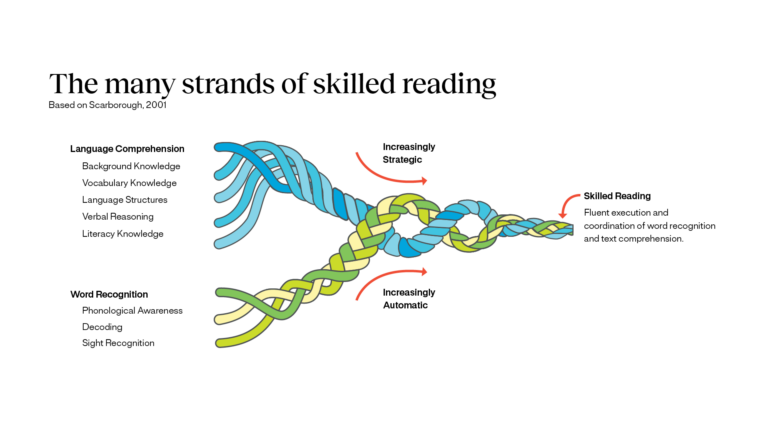A guide to effective reading comprehension interventions

There are key foundational skills that are supported by the findings of the National Reading Panel in 2001 and those research findings still hold true today. One of the areas the panel studied was comprehension. Reading comprehension acts not only as a skill to be taught, but also as an arrival point of sorts: the ultimate goal of reading instruction is an in-depth understanding of what one reads.
Although reading comprehension plays a crucial role in academic success and lifelong learning, many students struggle with understanding and retaining what they read, which can greatly affect not only their performance in all subject areas but also the way they view themselves.
In this comprehensive guide, we’ll explore effective interventions for reading comprehension to help students overcome reading comprehension challenges and fully understand the complex texts they encounter.
Understanding reading comprehension difficulties
Through our growing understanding of the science of reading and how children learn to read, we have come to recognize that there are multiple components that lead to our ultimate goal of reading comprehension. Scarborough’s Rope, a model showing the interdependence of word recognition and language comprehension necessary for proficient reading, details how the subcomponents of word recognition and language comprehension eventually weave together to enable skilled reading. Scarborough defines this as the “fluent execution and coordination of word recognition and text comprehension.” This essentially lies at the heart of all the work we do with literacy instruction. Let’s look a little more closely at these two domains in the “Reading Rope” to see what skills children need in order to comprehend written text.

Word recognition
Word recognition comprises what we consider to be early foundational literacy skills:
- Phonological and phonemic awareness: large and small units of spoken language
- Decoding: alphabetic principle and orthographic mapping
- Sight recognition of learned words and spelling patterns
Mastery of these skills creates increasing automaticity of reading at the word level. Once children have this automaticity, their cognitive load is lightened and they can attend to or offer more bandwidth to understanding the meaning of the text.
Language comprehension
Language comprehension —which is a separate component on the Reading Rope, but which should be taught in tandem with word recognition skills—are comprised of the following components:
- Background knowledge: Bank of knowledge based on life experiences and previous learning
- Vocabulary knowledge: Explicit and implicit vocabulary instruction + morphological units and word analysis skills for complex vocabulary
- Language structures: Knowledge of language structure from phonetics through morphology, syntax, and text structure
- Verbal reasoning: The way we think with and about words, from following instructions to problem-solving
- Literacy knowledge: Print concepts, genre, and everything involved with the purpose, features, and conventions of text.
These skills and capabilities continue to grow throughout our lifetime and are critical for our students to develop —especially as they move through early elementary and into the upper elementary grades and beyond. Integration of all of these components allows students to read and demonstrate understanding of increasingly complex texts, as they will be expected to do.
As you can see, there are many places along the strands that make up Scarborough’s Rope where skills can break down and impede the development of reading comprehension. These difficulties may include foundational issues with phonemic awareness and decoding multisyllabic words, trouble with working memory and ability to recall familiar words and spelling patterns, lack of vocabulary knowledge, limited background knowledge, and poor understanding of text structure. Identifying the specific areas of difficulty for each student is always the first step in designing effective interventions.
Types of comprehension interventions
Once you have a clear idea of where a student is having difficulty, there are various approaches to improving reading comprehension, each targeting different aspects of the layered skill. Many of these can be taught in a whole or small group setting or within a Multi-Tiered System of Supports (MTSS) framework. Some common comprehension interventions include:
- Explicit Instruction: Teacher directed lessons in either a small group or 1-1 setting. Directly layering in lessons will fill gaps and thus help a student grow stronger in a specific area. This is especially important for those needing to strengthen early literacy skills, such as phonemic awareness or decoding skills. Once students have the time needed to recover the necessary skills, they can begin working toward grade-level comprehension. Explicit instruction in high-impact comprehension strategies may also be important for some students.
- Read-alouds: Teacher-modeled thinking using read-alouds for comprehension strategies such as summarizing, questioning, and making inferences. This modeling helps to “lay a blueprint” at the listening level which can then be applied with specific instruction in comprehension strategies.
- Graphic Organizers: Using visual aids like charts, diagrams, and story maps to help students organize and understand the structure of texts. Students must first be explicitly taught how to use graphic organizers to gain independence with this type of strategy.
- Close Reading: Encouraging students to analyze and critically engage with texts by focusing on details, author’s purpose, and context. Offering students question stems that help to encourage high-order thinking is often helpful for those who aren’t sure where to begin.
- Vocabulary Instruction: Building students’ vocabulary through both explicit teaching of words and their meanings and through strategy instruction, such as how to break down unfamiliar words so that students can learn independently as they come across words they don’t know. Additionally, teaching students how to use tools like the dictionary or their own background knowledge with the context of a word may be helpful and effective.
Choosing the right intervention
When selecting a comprehension intervention, it’s essential to consider the individual needs and strengths of each student. For some students, for example, it might not be clear at first where the skill deficit is. Students can appear to be able to decode words, but when they are reading on their own and can’t figure out a multisyllabic word, it’s possible they are just skipping over it. Others may have sound early literacy skills and just need direct instruction on some reading comprehension strategies.
Many people don’t have the understanding that underneath an inability to decode can lie a skill gap in phonemic awareness or phonics that was never addressed. An assessment of these early literacy skills helps to ensure that students will receive explicit instruction in phonemic awareness and phonics in order to build the foundation they will need, and is the most effective first step. When students are showing proficiency in these early skills, then teachers can determine what additional skills need strengthening and which comprehension intervention strategies are most appropriate. Some of this will depend on the student’s age and what type of learning environment they will most benefit from. Additionally, collaboration between teachers, reading specialists, and other support staff is critical to ensure a tailored approach that meets the unique needs of each student.
Implementing interventions effectively
Successful implementation of anything requires a lot of patience and follow-up to ensure sustainability. This is true also of reading comprehension interventions. An intervention requires careful planning, consistent monitoring, and transparent and frequent communication between all invested parties—particularly if there are multiple subject-based teachers and specialists. Teachers should provide explicit instruction, model strategies, and offer plenty of opportunities for guided and independent practice. Ongoing assessment and progress monitoring are also crucial to ensure that interventions are effective and responsive to students’ changing needs.
Reading intervention success stories
While every student’s journey to improved reading comprehension is unique, there are countless success stories that demonstrate the effectiveness of targeted interventions. From readers making significant gains to students developing a newfound love for reading, these stories highlight the transformative power of evidence-based intervention strategies.
Here are a few intervention success stories from our partner schools:
95 RAP shines a light on Tier 3 literacy intervention in North Carolina
Two schools in Franklin County, North Carolina are unlocking literacy for Tier 3 intervention students with 95 RAP™, our teacher-led, digital, small group intervention solution. Read the full story to hear about how they have implemented this science of reading-aligned tool in order to help close literacy skill gaps with personalized learning.
Within the small group, 95 RAP targets each learner’s area of need, and doesn’t allow them to move on to the next skill until they have mastered the one they are working on.
Amber Bottoms
Best practices for your Tier 2 literacy solution: Lessons learned from a California school district
A conversation with David Mack, EdD, Chief Administrator of Business Services, and Charley Clark, Assistant Superintendent at Fairfax School District in Bakersfield, CA to discuss the successful Tier 2 implementation that catalyzed Fairfax School District’s structured literacy journey.
The plan was very structured—we had six-week cycles of intervention, not just “You’re in intervention for life.” We’re going to do six-week cycles. We’re going to pre-test. We’re going to post-test. Our goals were to meet the individual needs of the students.
Charley Clark
The final word
Effective reading comprehension interventions can make a significant difference in the lives of readers. By understanding the nature of comprehension difficulties, selecting appropriate intervention strategies, and implementing them with care and consistency, educators can help students unlock their full potential and become confident, proficient readers.
Whether you’re a teacher, reading specialist, or parent, investing in evidence-based reading comprehension interventions is an investment in the future success of our students. With dedication, collaboration, and the right support, every child can develop the abilities they need to thrive.
Resources
- National Reading Panel (U.S.) & National Institute of Child Health and Human Development (U.S.). (2000). Report of the National Reading Panel: Teaching children to read : an evidence-based assessment of the scientific research literature on reading and its implications for reading instruction. U.S. Dept. of Health and Human Services, Public Health Service, National Institutes of Health, National Institute of Child Health and Human Development.
- Scarborough, H. S. (2001). Connecting early language and literacy to later reading (dis)abilities: Evidence, theory, and practice. In S. Neuman & D. Dickinson (Eds.), Handbook for research in early literacy (pp. 97–110). Guilford Press.



